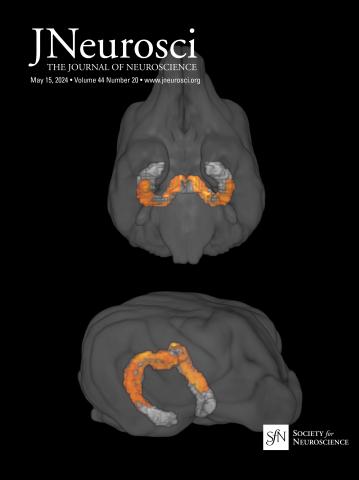The orbitofrontal cortex underlies consolidation of Pavlovian anticipatory arousal responses in macaque monkeys.
IF 4
2区 医学
Q1 NEUROSCIENCES
引用次数: 0
Abstract
Altered arousal is characteristic of many mental health disorders, including major depressive disorder (MDD). Several studies link neural activity in orbitofrontal cortex (OFC) with anticipation of reward, including anticipatory sympathetic arousal, which is blunted in MDD. We therefore studied acquisition and consolidation of appetitive Pavlovian memories in two groups of adult male rhesus monkeys: unoperated controls (N = 4) and those with selective neurotoxic lesions of OFC (N = 4). The dependent measure was conditioned sympathetic arousal as indexed by differential pupil dilation, and the key comparison was dilation in response to a visual cue that predicted the delivery of a large fluid reward (CS+) vs. a cue that predicted no reward (CS-). Control procedures ruled out global effects of the lesion on pupil dilation. All four unoperated controls and all four monkeys with OFC lesions acquired a conditioned increase in pupil size in response to the CS+. However, three of the four monkeys in the lesion group failed to consolidate the memory underlying this response. In contrast to this impairment, monkeys with OFC lesions acquired and consolidated an operant visual discrimination for the same reward and did so at the same rate as controls. These findings point to a specialized role for OFC in consolidating memories underlying positive affective responses, which further implicates OFC dysfunction in the blunted positive affect characteristic of MDD and suggests therapeutic approaches involving enhanced consolidation and/or reconsolidation of associative memories.Significance statement Blunted anticipation of positive events is characteristic of many mental health disorders, including major depressive disorder (MDD). Cortical circuits underlying anticipatory responses have been identified in rodent models, but it is likely that different mechanisms operate in anthropoid primates, the clade that includes humans and monkeys. Anthropoids have cortical areas that rats and mice lack, and here we show that-in a macaque monkey model-some of these areas are necessary for consolidating memories that produce autonomic arousal in anticipation of rewards. Specifically, the integrity of granular orbitofrontal cortex (OFC)-the part of OFC specific to primates-is essential for macaque monkeys to consistently generate arousal in response to visual cues that predict positive events.眼窝额叶皮层是猕猴巴甫洛夫预期唤醒反应巩固的基础。
觉醒改变是许多精神健康障碍的特征,包括重度抑郁症(MDD)。一些研究将眼窝额叶皮层(OFC)的神经活动与对奖赏的预期联系起来,包括预期交感神经觉醒,这在重度抑郁症中是钝化的。因此,我们研究了两组成年雄性恒河猴的食欲性巴甫洛夫记忆的获取和巩固:未手术对照组(N = 4)和选择性OFC神经毒性病变组(N = 4)。依赖的测量是条件交感神经唤起,由瞳孔的差异扩张来指示,关键的比较是对预测提供大液体奖励的视觉线索(CS+)和预测没有奖励的线索(CS-)的扩张反应。对照程序排除了病变对瞳孔扩张的整体影响。所有4只未手术的对照组和所有4只OFC病变的猴子在CS+反应下瞳孔大小都有条件增加。然而,病变组的四只猴子中有三只未能巩固这种反应背后的记忆。与这种损伤相反,有OFC损伤的猴子获得并巩固了对相同奖励的操作性视觉辨别能力,其速度与对照组相同。这些发现指出OFC在巩固记忆中扮演着特殊的角色,这是积极情感反应的基础,这进一步暗示了在MDD的积极情感特征减弱中OFC功能障碍,并建议治疗方法包括加强联想记忆的巩固和/或再巩固。对积极事件的迟钝预期是许多精神健康障碍的特征,包括重度抑郁症(MDD)。在啮齿类动物模型中已经确定了预期反应的皮层回路,但在类人猿灵长类动物(包括人类和猴子)中,可能存在不同的机制。类人猿拥有大鼠和小鼠所缺乏的皮质区域,我们在这里展示了,在一个猕猴模型中,这些区域中的一些是巩固记忆所必需的,这些记忆在预期奖励时产生自主觉醒。具体来说,颗粒状眼窝前额皮质(OFC)的完整性——这是灵长类特有的OFC部分——对于猕猴在预测积极事件的视觉线索下持续产生唤醒至关重要。
本文章由计算机程序翻译,如有差异,请以英文原文为准。
求助全文
约1分钟内获得全文
求助全文
来源期刊

Journal of Neuroscience
医学-神经科学
CiteScore
9.30
自引率
3.80%
发文量
1164
审稿时长
12 months
期刊介绍:
JNeurosci (ISSN 0270-6474) is an official journal of the Society for Neuroscience. It is published weekly by the Society, fifty weeks a year, one volume a year. JNeurosci publishes papers on a broad range of topics of general interest to those working on the nervous system. Authors now have an Open Choice option for their published articles
 求助内容:
求助内容: 应助结果提醒方式:
应助结果提醒方式:


